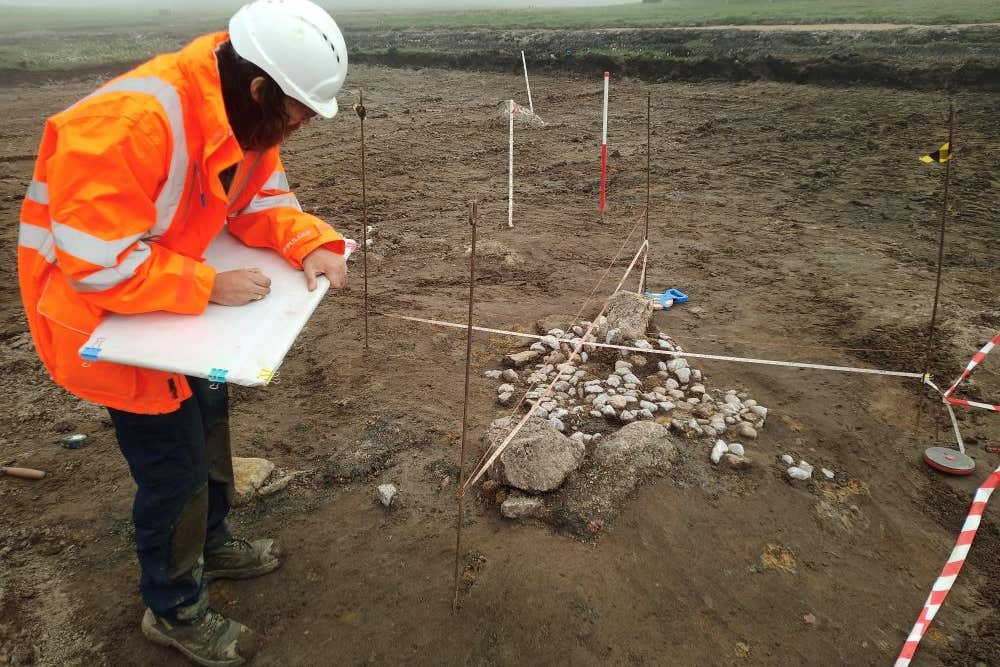‘Bronze age ritual cemetery’ discovered at planned Shetland spaceport
Spaceport officials said they will work with archaeologists as they continue to uncover the ancient remains.

Archaeologists working at a planned Shetland spaceport have discovered what appears to be a bronze age ritual cremation cemetery.
The remains were uncovered while foundation work was carried out at the SaxaVord spaceport site on the Lamba Ness peninsula in Unst, Shetland.
Pits, large boulders and cremations were uncovered alongside a quartz setting, which is generally associated with prehistoric burial tombs.
Excavation is still in its early stages, but archaeologists believe the remains date to between 2200-1800 BC.
The discovery will offer archaeologists a fresh opportunity to study prehistoric inhabitants of Shetland, and will not hold back the development of the spaceport.
The bronze age is perhaps the period of Shetland’s past which we know least about and this is a wonderful opportunity to change that
Shetland’s regional archaeologist, Dr Val Hunter, said: “I’ve always suspected that some of Shetland’s rings of boulders and low stones found could in fact be bronze age cremation cemeteries, so it is hugely exciting to be proved right.
“The bronze age is perhaps the period of Shetland’s past which we know least about and this is a wonderful opportunity to change that.
“With the modern techniques available now, we can potentially find out far more about the individuals who lived and died here than we could have discovered even 20 years ago.
“Hats off to the archaeologists from AOC who spotted this in the watching brief.”
The discovery was welcomed by SaxaVord chief executive Frank Strang, who said the spaceport would work with archaeologists in theirexcavation.
He said: “This is a tremendously exciting discovery and we will be supporting further study of the remains to find out the full story.
This is a tremendously exciting discovery and we will be supporting further study of the remains to find out the full story
“With Unst’s Viking heritage, we had always thought of the timespan from the longship to the spaceship. Now we know there has been activity on our site for more than 4,000 years, it’s the bronze age to the space age”
Katie O’Connell, project manager at AOC Archaeology, said: “The several deposits of burnt bone which have been found are likely associated with the remains of cremation deposits.
“The number and density of cremations suggest that the location of their discovery was likely a cremation cemetery that may have been in continuous use over time in prehistory.
“A standout feature uncovered so far is the remains of a quartz setting. White quartz is often suggested to have had significance in prehistory and is found in association with burial tombs, rock art panels and deposited carefully at domestic sites.
“At the spaceport, quartz pebbles have been found in a hollow, with larger stones at each end. These stones would have been carefully selected and placed to form this bright white platform.
Further large pits are scattered across the area suggesting multiple uses of the site over time
“The purpose of this platform is unknown at the moment, however it may have been associated with a burial that has not survived.”
Ms O’Connell added: “Large boulders of the local Skaw granite have been found placed in some of the pits and are aligned forming a broad arc.
“Large pits in between the boulders may have once held stones that have become removed or displaced over the intervening millennia.
“Further large pits are scattered across the area suggesting multiple uses of the site over time.
“Though excavation is only beginning, there may be a relation between the large stones, alignments of pits, the quartz setting and the cremation cemetery, suggesting that together these form part of a ritual complex.”
Subscribe to Independent Premium to bookmark this article
Want to bookmark your favourite articles and stories to read or reference later? Start your Independent Premium subscription today.
